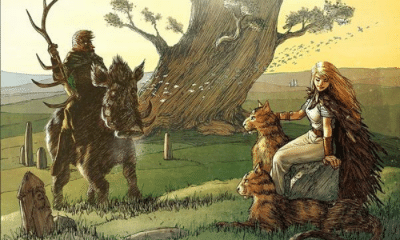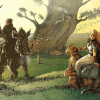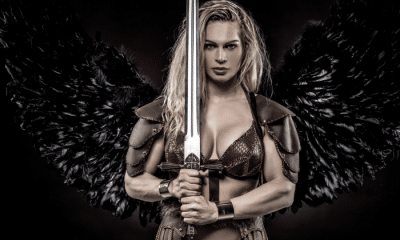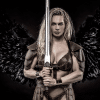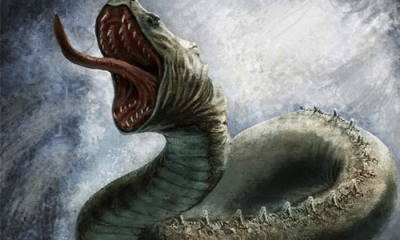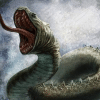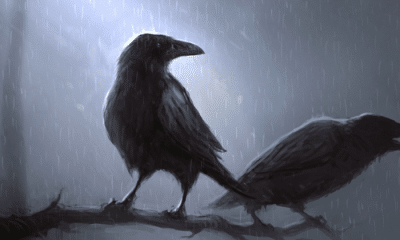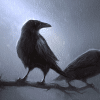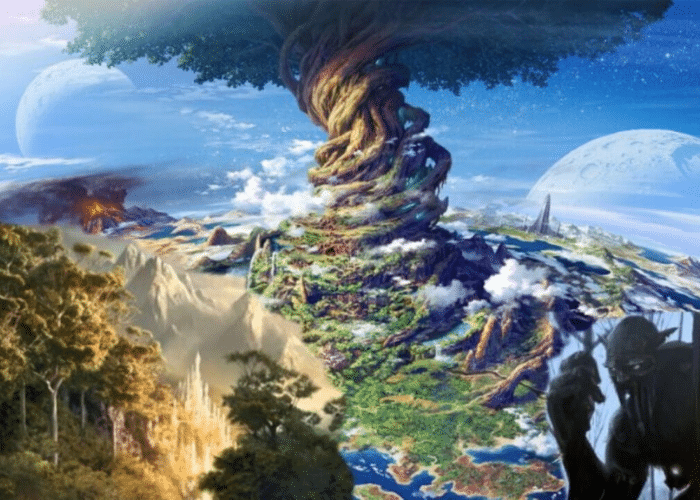
Norse
The Nine Worlds of Norse Legend
The Nine Worlds of Norse Legend
Norse mythology sometimes refers to the Nine Worlds. How much do you really know about the realms of Norse cosmology and who lived on each?
The phrase Nine Worlds is used often in describing Norse cosmology. Most scholars identify the Nine Worlds of Norse creation as being the homes of the various races mentioned in the legends.
The most important of these, at least as far as Norse writers were concerned, was Midgard. This was the home of the human race and the only world that most humans were aware of.
Before Midgard was made, two primordial worlds existed. These were worlds of fire and ice.
Two other worlds belonged to the gods. Each of the two coexisting pantheons made their homes in their own world.
The remaining four worlds are less clearly identified. They were the homelands of various mythological races, but exactly what they were called and who lived there is sometimes open to debate.
While the worlds were generally separated, some travel between them was possible for the gods. They would truly come together, however, when the people of at least four worlds fought on Midgard at Ragnarök.
The Primordial Worlds
According to the Norse creation myth, the Nine Worlds were created around Yggdrasil, the great World Tree. Before they were created, however, there was a vast empty space called Ginnungagap.
The higher regions of Ginnungagap were bitterly cold while the lower area grew increasingly hot. Eventually, these areas became the first primordial worlds.
Niflheim, the land of mists, was a realm of ice and fog. The ground froze solid and no living thing could survive the extreme temperatures.
Muspelheim on the opposite extreme was a realm of fire.
According to some accounts, both of these worlds were eventually inhabited by a race of giants well-suited to the extreme temperatures.
The heat of Muspelheim and the frozen ice of Niflheim eventually began to interact. The rising warmth made the ice beneath Niflheim slowly melt, and the dripping water evaporated into mist when it fell toward Muspelheim’s fires.
In Ginnungagap, this mist slowly began to coalesce into two distinct shapes. First, the giant Ymir emerged from the mist. Then came an enormous cow that was known as Auðumla.
Ymir drank the cow’s milk. Auðumla subsisted by licking the salty ice that accumulated on Niflheim.
The ice slowly began to take shape as Auðumla licked it. This became the first god, Búri, who went on to have a son named Borr.
Ymir, too, gave rise to new life. The first jötnar, or giants, were born from his sweat.
Borr’s wife Bestla was likely one of these early giants. Together, they had three sons named Odin, Vili, and Vé.
The three young gods had no home of their own and were outnumbered by Ymir’s often cruel offspring. The ancestral giant was also unkind and demanding.
In dealing with Ymir, the three gods ended up creating the first world in the center of Ginnungagap.
The Creation of Midgard
The three brothers decided to kill Ymir so they no longer had to suffer his abuse. Although he was large and powerful, they easily defeated him.
The blood that spilled from Ymir’s body washed away most of the cruel frost giants. Only a few remained, and they became the ancestors of the jötnar.
Ymir’s body took up a large area in the center of Ginnungagap. Odin and his brothers decided to use it to make a new world, the first to be made after the primordial worlds.
Ymir’s body became the surface of the land. His blood was collected and contained to make seas and rivers.
The gods used his bones and teeth to make mountains and fjords. Great mountain ranges and tall cliffs were sculpted in this way.
The giant’s skull was placed over the new world to make the dome of the sky. The brains that remained in it floated through the space as clouds that floated through it.
The brothers captured sparks that flew up from Muspelheim and placed them in the new sky. These became the sun, moon, and stars that gave light to the world.
In other accounts, the sun and moon were made from Ymir’s eyes. They would be carried in chariots by later gods.
Ymir’s hair and beard were used to form plants. Short grass and tall trees were all made from the giant’s hairs.
The brothers knew that their new world needed to be made safe from the jötnar, many of whom were still malicious. They used Ymir’s eyebrows to make a protective wall that encircled the new world and keep it safe from attack.
They called this world Midgard, the “Middle Yard,” because it was in the center of Yggdrasil and because the middle was enclosed like a safe yard. This is sometimes written in modern English as Middle Earth.
The brothers were pleased with their world and decided to create new people to inhabit this world. They carved Ask and Embla, the first man and woman, from the branches of trees and gave them life.
According to the Prose Edda, however, these first humans were unintelligent and incapable of surviving. Some of the newer Aesir gods helped Odin to give humans the capacity for knowledge.
The Worlds of the Gods
The Norse creation myth details the world of men and the primordial realms of ice and fire, but it does not say how the other six worlds were created. In fact, it does not even specify what these worlds were.
Scholars generally agree, however, that two of the worlds were the homes of the gods. These were Asgard, the home of the Aesir, and Vanaheim, the land of the Vanir.
Like Midgard, Asgard was a fortified world. A large wall surrounded at least twelve realms, each of which was the home of an individual god or couple.
This fortification is known to have been damaged in the war between the Aesir and Vanir gods. In the story of how Loki gave birth to Odin’s horse, Sleipnir, a builder is hired to rebuild the fallen wall.
Asgard was connected to Midgard by a rainbow bridge called the Bifröst. It originated in Himinbjörg, the home of Heimdall.
Man of the other realms of Asgard are mentioned only rarely and never described in great detail. The most famous region of Asgard, however, was Valhalla.
This was where Odin house the Einherjar, warriors who had been chosen by the Valkyries from the battlefields they died on.
Valhalla was a great hall that was said to be so enormous that no matter how many warriors joined the Einherjar they would never be crowded. It also had a large courtyard in which the Einherjar fought daily battles for entertainment.
If little was said of Asgard, even less was mentioned about Vanaheim. One of the clearest mentions of this world is in the Poetic Edda. It is not described in detail, but given as the answer to the question of where the god Njörðr originated.
In Vanaheim wise powers him created,
and to the gods a hostage gave.
At the world’s dissolution,
he will return to the wise Vanir.
-Poetic Edda, Vafþrúðnismál (trans. Thorpe)
The Confused Worlds Underground
While Asgard and Vanaheim were not spoken of in great detail, their residents and purposes were at least clear. The same cannot be said for many of the other worlds of Norse cosmology.
In lists of the Nine Worlds, it is often unclear whether or not Helheim should be included. While it is sometimes named as its own realm, literary sources imply that it was within Niflheim.
Helheim is most often excluded from the list of the Nine Worlds because of this.
Two other underground worlds present another problem, however. Svartálfheim and Niðavellir are worlds whose residents are unclear.
There are three races who are variously said to inhabit one of these two worlds. They are
- Svartálfr – The Black Elves
- Dvergr – The Dwarves
- Dökkálfar – The Dark Elves
Many interpretations hold that dökkálfar and svartálfr were two names given for the same race which lived in Svartálfheim. The Dwarves lived on Niðavellir, which is also sometimes called Myrkheim, or “Dark Home.”
This is not entirely clear in surviving literature, however.
The dökkálfar and svartálfr are both mentioned only rarely and their nature is never made clear. Unlike the dwarves and giants, the dark or black elves played very little role in mythology.
Oddly, when the term svartálfr is used, it typically seems to refer to the dwarves rather than a type of elf.
When Loki needs to fetch new golden hair for Sif, for example, he does not go to Niðavellir. He travels to Svartálfheim and the people there are called svartálfr and dvergr almost interchangeably.
Some people thus think that Svartálfheim was the home of the dwarves while Niðavellir or Myrkheim belonged to the mysterious creatures known as the dark elves.
Lands of Elves and Giants
The remaining worlds are luckily more clear. These are Álfheim, the home of the elves, and Jötunheim, the world of the giants.
While elves play a central role in the modern imagination, they appear much less often in Norse mythology. They are often treated as minor gods, but do not play a part in many well-known myths.
Their world is similarly unmentioned. One of the few clear mentions of Álfheim in surviving literature actually says that the elves did not even retain ownership of their own world.
Instead, a poem in the Poetic Edda says that Álfheim was given to Freyr by the other gods as a “tooth gift,” a present given to infants when they cut their first tooth.
Another text mentions mansions in the highest heaven called Vídbláinn that only the elves inhabit. Because it is unclear whether this refers to a part of Álfheim or not, it is possible that the home of the elves may not even be that world.
Jötunheim is far more clearly referenced in surviving literature and the jötnar play a much larger role.
Jötnar are often thought of as giants, but that term is imprecise. Some were god-like, such as Loki and Skaði, while others were similar to trolls or other semi-human creatures.
While some of the jötnar were on good terms with the gods, their world was still a dangerous place to travel through. The gods often traveled to Jötunheim.
Mímir’s Well was said by some sources to under the root of Yggdrasil that rested in Jötunheim. Odin trekked through the world to reach the well and drink from the magical water there.
In another story, several of the gods were accosted by the giant Þiazi during a trip through Jötunheim’s mountains. A series of escalating problems caused by Loki led to that jötun’s death and the marriage of his daughter, Skaði, to one of the gods.
This story also hints at the fact that Jötunheim resembled Midgard in many ways.
Skaði married Njörðr, a god of the sea. Neither was happy because she preferred the mountains while he loved the ocean.
One story of their marriage recounts Njörðr’s complaint that the howling wolves outside of Skaði’s home kept him awake. This shows that the landscape and wildlife of Jötunheim were similar to Midgard’s wilderness.
Some interpret Jötunheim not as an entirely separate world, but as one that existed outside of Midgard’s enclosure. While humankind lived within the wall the gods had made from Ymir’s eyebrows, that giant’s descendants live on the same plane but outside of those walls.
The Destruction of the Worlds
More famous than the creation of the worlds in Norse mythology was the way in which they would end.
Ragnarök was the culmination of all Norse myths. Several stories include the destiny of the gods that leads them toward the end of all things.
Like most myths, however, the story of Ragnarök concerns only a handful of worlds.
Niflheim and Muspelheim are mentioned as realms from which the enemies of the gods will march forth. The fire giants of Muspelheim will join the frost giants of Niflheim and Hel’s dead in war against the gods and men.
In one account, Jötunheim is mentioned as a world that receives news of Ragnarök’s beginning, but it is unclear how involved that world is in the battle itself.
Even Vanaheim is not mentioned. A few Vanir gods are mentioned as taking part in the fight, but nothing is said of their homeworld’s fate.
Most of the action of Ragnarök takes place on Midgard, the land of men.
After three brutal years of winter, it is Midgard that will be invaded by the hosts of Muspelheim and Niflheim. Monsters like Fenrir and Jörmandgandr will also wreak havoc on that world.
It is implied that the battlefield that has been designated for the gods’ last stand is on Midgard rather than in Asgard.
Midgard will be utterly destroyed by Ragnarök. The only living things to survive will be one human couple that escapes into Yggdrasil’s branches.
The land itself will be consumed by the battle. The fire giants will set fire to Midgard and the burned land will sink beneath the sea.
The only other world that is described in any detail in accounts of Ragnarök is Asgard.
The fire giants will attempt to cross the Bifröst and reach the home of the Aesir. The bridge will crack beneath them, however, implying that they do not reach the gods’ world in force.
Asgard is not destroyed in Ragnarök as Midgard is. The surviving gods reconvene there after the battle to start a new pantheon and rebuild.
The world of the Aesir is damaged, however. Baldr and his brother search for their old game pieces in the ground, implying that the halls of the gods have been destroyed by the land itself remains.
Muspelheim and Hel are depopulated after the war. The fire giants and Hel’s army of the dead do not return, but those realms are otherwise unchanged.
Nothing is said of how the other five worlds fare in Ragnarök. Because they are not mentioned, it can be assumed that they are not invaded or destroyed.
Ragnarök is therefore not the end of all worlds, but only of the worlds of men and the gods. Both are reborn, however, leaving the overall Norse cosmology virtually unchanged.
The Nine Worlds
Norse cosmology sometimes describes the Nine Worlds that existed along Yggdrasil, the world tree.
The first of these were Muspelheim and Niflheim, the primordial worlds of fire and ice. The interaction between the ice and heat eventually created a mist that gave rise to the first living things.
One of these was Ymir, the ancestor of all giants. He was killed by Odin and his brothers and his body was used to create Midgard, the world of men.
Two worlds existed for the gods. The Aesir lived in Asgard while the Vanir lived in Vanaheim.
The jötnar, or giants, had their own world as well. Jötenheim was similar to Midgard but more dangerous.
The home of the light-elves is usually identified as Álfheim. This is rarely mentioned, however, as the elves played little role in most myths.
The remaining worlds are usually called Svartálfheim and Niðavellir, or Myrkheim. They are the homes of the dwarves and a little-known race of dark elves, although terms for both are often confused and used interchangeably.
Many of these worlds will be involved in Ragnarök. Muspelheim and Niflheim will be depopulated as their inhabitants attack the gods, Midgard will be totally destroyed, and Asgard will be badly damaged.
Eventually, however, both Asgard and Midgard will be rebuilt. It is implied that the Nine Worlds will continue in greater harmony than existed before.


